playing cards
baltic mythical creatures
The set of cards contains 61 card:
-56 standart playing cards (there are 4 joker cards in the set)
-4 cards with descriptions of the mythical creatures
-1 card with logo and contacts
26 €
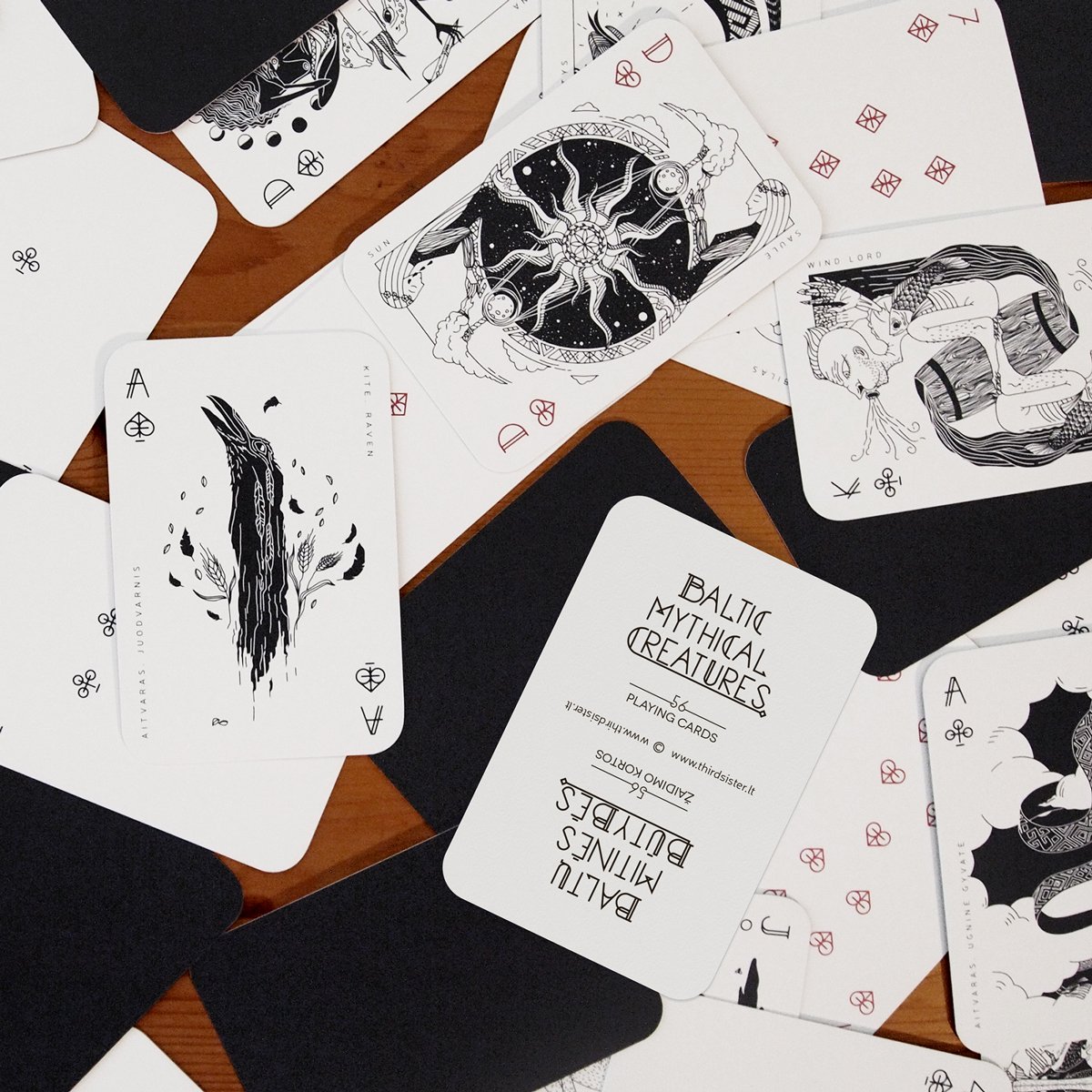
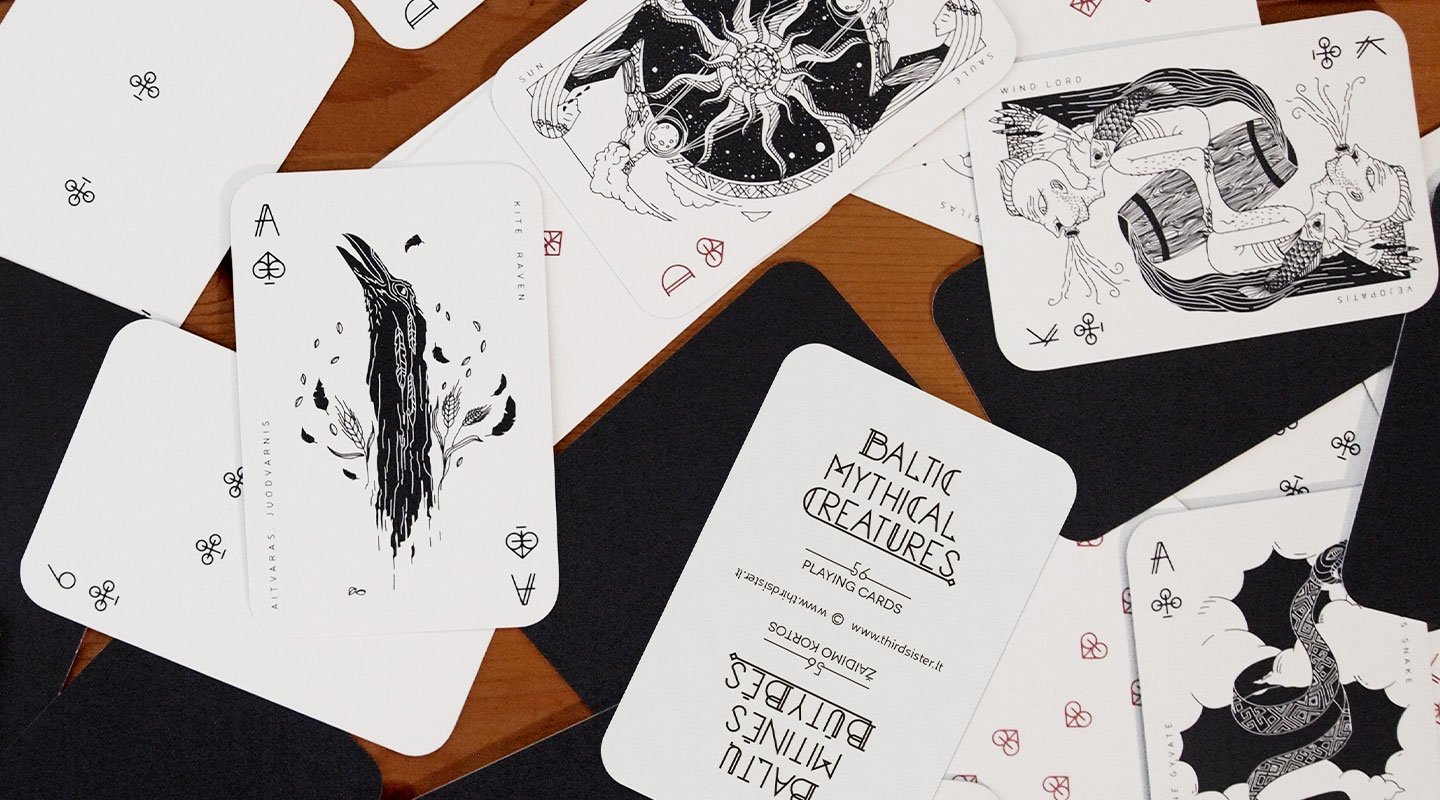

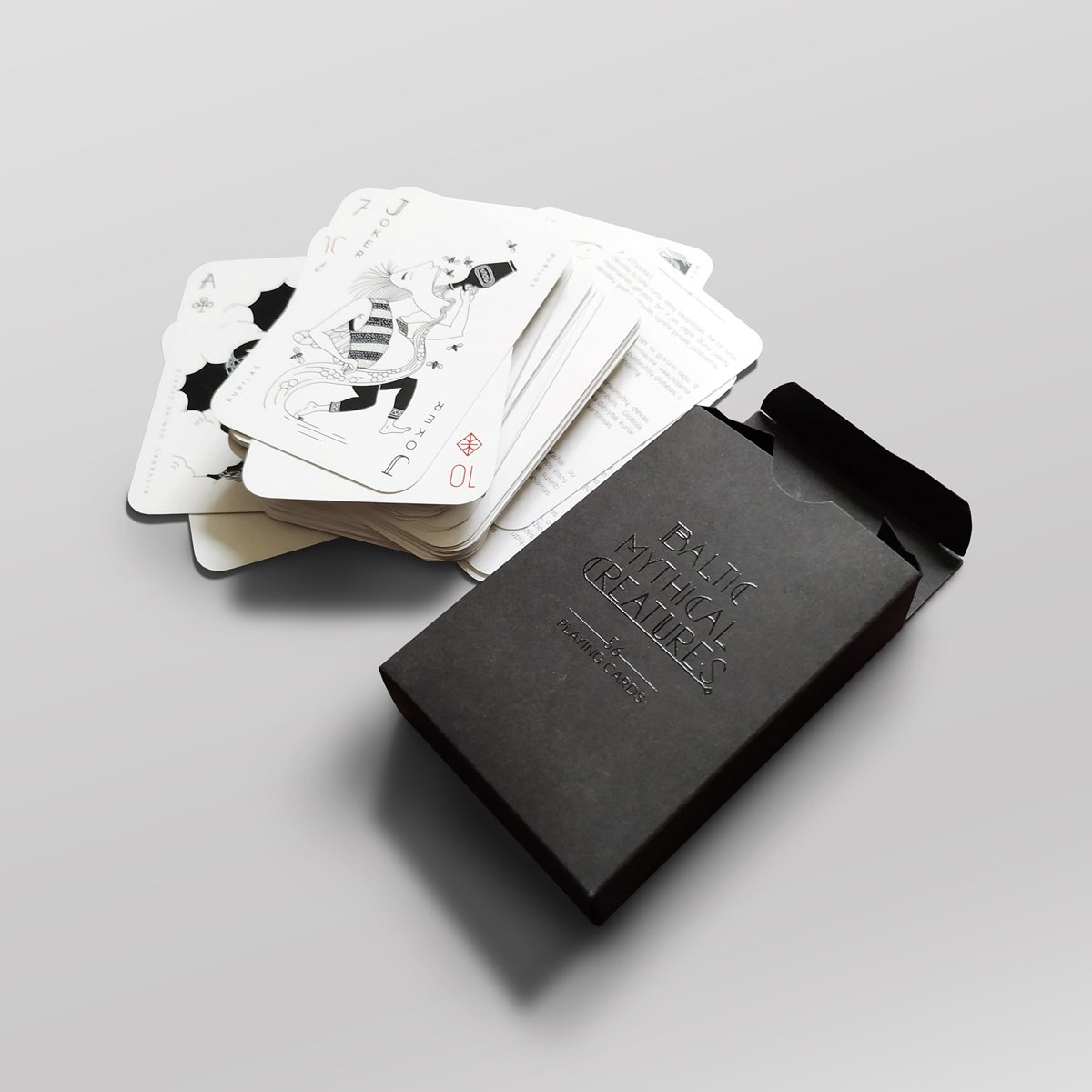
about
Playing Cards “Baltic Mythical Creatures” is my personal project to illustrate standard playing cards with Baltic gods, goddesses and other mythical creatures. The set of cards contains 20 illustrations. All of them are my personal interpretation of Mythical Baltic creatures, which is based on a variety of written and visual material. Card signs represent one of the four spheres the mythical creature belongs to: harts – skies, diamonds – air, clubs – water and spades – earth.
Names of the mythical creatures are displayed on the cards in Lithuanian and English. The box also contains English and Lithuanian descriptions of the creatures, so you will have a chance to learn more about Sea God VĖJOPATIS, mysterious Pixies and wickedness of Baltic Devil.
Alsow you can find it
INTERNET SHOPS
etsy.com
BALTIK SHOP RAGAINĖ
Skapo g. 3, Vilnius
BALTIC SHAMANS
Užupio g. 2, Vilnius
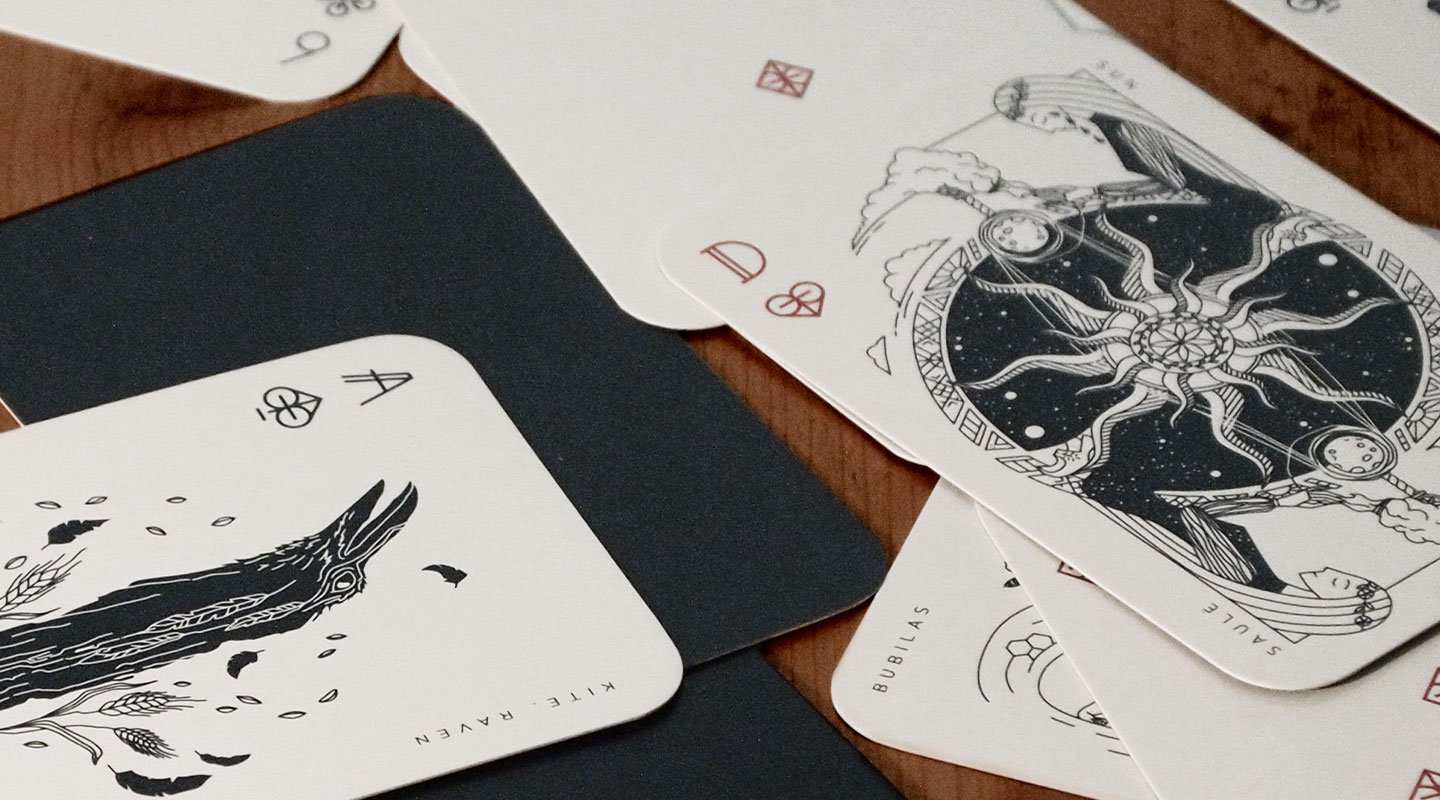
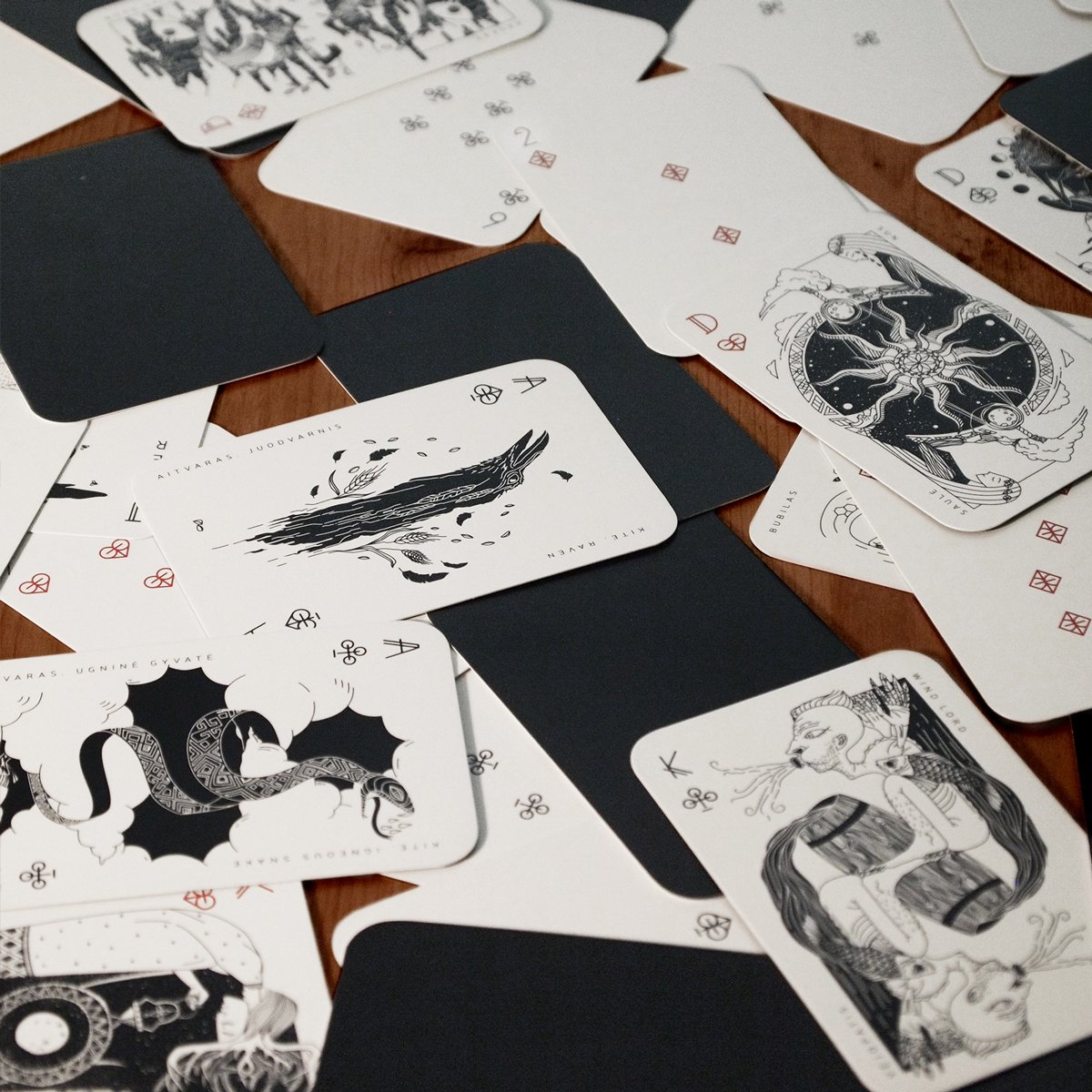

descriptions
THE MOON
The God of the nocturnal light, a lantern of the night. Promoter of plant growth. The spouse of the Sun. Previously, the Moon was given the form of a nine-horned deer, however, later it started to be depicted as a handsome young man dressed in silver clothes.
THE SUN
The Goddess of warmth and health, life and fertility. She was minted by a mythical blacksmith named Teliavelis. She is a patron of unfortunate ones, especially orphans. The Sun is depicted as a girl with golden or flax-coloured hair, wearing long golden dress and beautiful wreath of flax flowers. She spins, sews or hand-washes linen. The Sun smiles, laughs, but she is also sometimes sad and cries or even weeps with bloody tears.
THE STAR GOD*. Local name – ŽVAIGŽDIKIS /ʒwɑɪgʒˈdɪkɪs/.
The God of stars. When necessary, he provides light for crop, grass, and cattle. It is said that the Star God had a sword and could have conquered the whole world by using it, but the sword was stolen by the Witch. The North Star is associated with him.
THE THUNDER*. Local name – PERKŪNAS /Perˈkuːnɑs/.
The God of thunder and lightning, masculinity, energy, the God of celestial fire. He brings new life to nature. The Thunder is depicted as a grey-haired old man with horns, along with a stallion and an axe in his hand.
THE EARTH GODDESS*. Local name – ŽEMYNA /ʒeˈmiːnɑ/.
The Goddess of soil fertility, the Mother Earth. She is a patron of the fields, agriculture, fruits and cattle. She is the Goddess that gives birth, grows, blooms, ripens and gets old. Her power lies within a flat stone.
THE WOOD SPIRIT*. Local name – KAUKAS /ˈkɑʊkɑs/.
The good spirit of fertility, harvest and prosperity. He doesn’t bring money, but helps to make the harvest long-lasting. The spirit of the woods is depicted as a small man in the shape of a tadpole. This good spirit lives in the forest, under the ground. He is visible at night in the moonlight, or on a foggy day.
THE WIND LORD*. Local name – VĖJOPATIS /veˈyopatɪs/.
The God of the seas, the lord of the skies. An evil spirit. He is stern and unrelenting. He is bearded, with wings and two faces, and a rooster on his head. This God holds a fish in his left hand and a vessel in the right. He sits on a high mountain, between two rivers.
THE PIXIE*. Local name – LAUMĖ /’ləʊme/.
An intermediary between the earthly and heavenly domains. She rewards people with material wealth, and sometimes lead to destruction and death. A spirit of prodigious beauty, with a large head, big eyes and the feet of a bird. Wrapped in a sheet, she does her laundry in the river. The spirit’s first form is a dove.
THE GRASS SNAKE*. Local name – ŽALTYS /ʒɑlˈtiːs/.
The deity of home, household fire, prosperity, and health. With shining scales and an awful stare. The king of grass snakes is crowned with a golden diadem.
THE DEVIL
The spirit of the dungeons which protects the treasures and the water that lie hidden deep in the earth. The Devil is closely related to the world of the dead. He is the patron of the poor, but punishes dishonest people. Heterogeneous, chaotic, and with many faces. One eye of the Devil can see everything.
THE WITCH
The Goddess of the forest, a herbalist. She obscures the Sun and controls the phases of the Moon. The Witch rules in the world of darkness and winter. Drinks the blood of infants to rejuvenate herself. A toad is the main form of embodiment of the Witch.
THE BUGABOO*. Local name – MAUMAS /’məʊ mas/.
A bugbear, a wraith. Formerly, people used to use the name of the Bugaboo to scare their children. The creature is covered with mucus and sludge. Bugaboo lives in a well or lake.
THE KITE*. Local name – AITVARAS /ˈɑɪtvarɑs/.
Divine being, a keeper of riches and treasures. Not only brings material riches, but also steals them. Comes in various forms: a rooster, a whirlwind, an igneous snake, and a raven.
THE HORN*. Local name – RAGUTIS /rɑˈgutɪs/.
The God of beer and mead. He is associated with an animal’s horn which is used for drinking from, but more importantly, to offer sacrifices to the gods. For this reason, the God of beer is not considered a patron of feasters, but is a soothsayer carrying light, sun and knowledge.
THE BUBILOS*. Local name – BUBILAS /ˈbubɪlɑs/.
The God of honey and bees, fertility and fun. A symbol of masculine fertility power. He is a patron of drone bees and mead. Bubilos is a demonic God. He likes to tempt people, to lead them astray. He consumes excessively.
THE SQUEAKY*. Local name – KRIUKIS /ˈkrukɪs/.
The deity of grown up piglets and swine.
THE IMP*. Local name – PINČIUKAS /pɪnˈtʃukɑs/.
The devil of the swamps, a wicked being. He is a trickster and behaves badly with people. He is blamed for all the misery and misfortune that happens to people. The Imp is able to trigger natural disasters and change his appearance. He is depicted as a tiny midget.
*Direct translation or equivalent.
MĖNUO
Nakties šviesos dievas – nakties žibintas. Augalijos augimo skatintojas. Saulės sutuoktinis. Anksčiau Mėnuliui buvo suteiktas elnio devyniaragio pavidalas, tačiau vėliau pradėtas vaizduoti kaip gražus jaunikaitis sidabriniais rūbais.
SAULĖ
Šilumos ir sveikatos, gyvenimo ir derlingumo deivė. Ją nukaldino mistinis kalvis Teliavelis. Globoja nelaiminguosius, ypač našlaičius. Vaizduojama kaip mergina su auksiniais ar linų spalvos plaukais, apsirengusi ilgais auksiniais drabužiais. Pasipuošusi linų žiedų vainiku. Verpia, siuva arba skalbia. Šypsosi, juokiasi, kartais liūdi, verkia, net rauda kruvinomis ašaromis.
ŽVAIGŽDIKIS
Žvaigždžių dievaitis. Reikiamu momentu teikia šviesą javams, žolei ir gyvuliams. Sakoma, kad Žvaigždikis turėjęs kalaviją, kuriuo galėjo užvaldyti pasaulį, bet jį pavogusi Ragana. Su juo siejama Šiaurinė žvaigždė.
PERKŪNAS
Griausmo ir žaibo, vyriškumo, energijos, dangiškosios ugnies dievas. Prikelia gamtą naujam gyvenimui. Vaizduojamas kaip žilas raguotas senis su eržilu ir kirviu rankoje.
ŽEMYNA
Žemės derlingumo deivė – Žemė Motina. Globoja laukus, žemės ūkio vaisius ir gyvulius. Ji yra gimdanti, auginanti, žydinti, prinokstanti ir pasenstanti deivė. Jos jėga glūdi plokščiame akmenyje.
KAUKAS
Vaisingumo, derliaus, turtų dvasia. Nešė ne pinigus, o skalsino turtą, gautą iš žemės. Vaizduojamas kaip mažas žmogelis, buožgalvio pavidalo. Buveinė miške, po žeme. Matomas naktį mėnesienoje arba ūkanotą dieną.
VĖJOPATIS
Jūrų dievas, dausų valdovas. Piktoji dvasia. Rūstus, nepermaldaujamas. Barzdotas, su sparnais ir dviem veidais, gaidžiu ant galvos, kairėje rankoje jis laiko žuvį, dešinėje – indą. Sėdi ant aukšto kalno, tarp dviejų upių.
LAUMĖ
Tarpininkė tarp žemiškosios ir dangiškosios sferos. Žmones apdovanodavo materialinėmis gėrybėmis, o kai kada lemdavo pražūtį ir mirtį. Stebuklingo grožio deivė didele galva, didelėmis akimis ir paukštės kojomis. Apsisiautusi marška skalbia prie upių. Pirmasis laumės pavidalas – paukštė karvelis.
ŽALTYS
Namų, židinio, gerovės, sveikatos dievybė. Spindinčiais žvynais, baimę keliančiu žvilgsniu. Žalčių karalius, vainikuotas aukso vainiku.
VELNIAS
Požemių dvasia, sauganti žemėje slypinčius lobius ir vandenį. Artimai susijęs su mirusiųjų pasauliu. Globoja vargšus, bet baudžia nesąžiningus žmones. Nevienalytis, chaotiškas, šimtaveidis. Viena Velnio akis viską mato.
RAGANA
Miško deivė, žolininkė. Užtemdo saulę bei valdo mėnulio fazes. Karaliauja tamsos ir žiemos pasaulyje. Geria kūdikių kraują, kad atsijaunintų. Pagrindinis įsikūnijimo pavidalas – rupūžė.
MAUMAS
Šmėkla, baidyklė, kuria gąsdina vaikus. Gleivėta, aptekusi maurais. Gyvena šulinyje arba ežere.
AITVARAS
Dieviška būtybė, turtų, lobių saugotojas. Ne tik neša materialines gėrybes, bet ir jas vagia. Būna įvairių pavidalų: gaidys, viesulas, ugninė gyvatė, juodvarnis.
RAGUTIS
Alaus ir midaus dievas. Susijęs su gyvūno ragu, iš kurio ne tik geriama, bet pirmiausia paaukojama dievams. Todėl Ragutis yra ne puotautojų globėjas, o žynys, nešantis šviesą, saulę ir žinojimą.
BUBILAS
Medaus ir bičių, vaisingumo ir linksmybių dievas. Vyriškosios vaisingumo jėgos simbolis. Globoja tranus ir midų. Bubilas yra demoniška dievybė, kuriai rūpi vilioti, vesti iš kelio. Jis – besaikis vartotojas.
KRIUKIS
Užaugusių paršų ir kiaulių dievas.
PINČIUKAS
Pelkių velnias, nelabasis. Elgiasi negražiai su žmonėmis ir krečia išdaigas. Jam suverčiamos visos nelaimės, kurios ištinka kaimo žmones. Gali sukelti gamtos stichijas, keisti savo išvaizdą. Vaizduojamas kaip nusmurgęs neūžauga.
Personal project
– 2019 –
